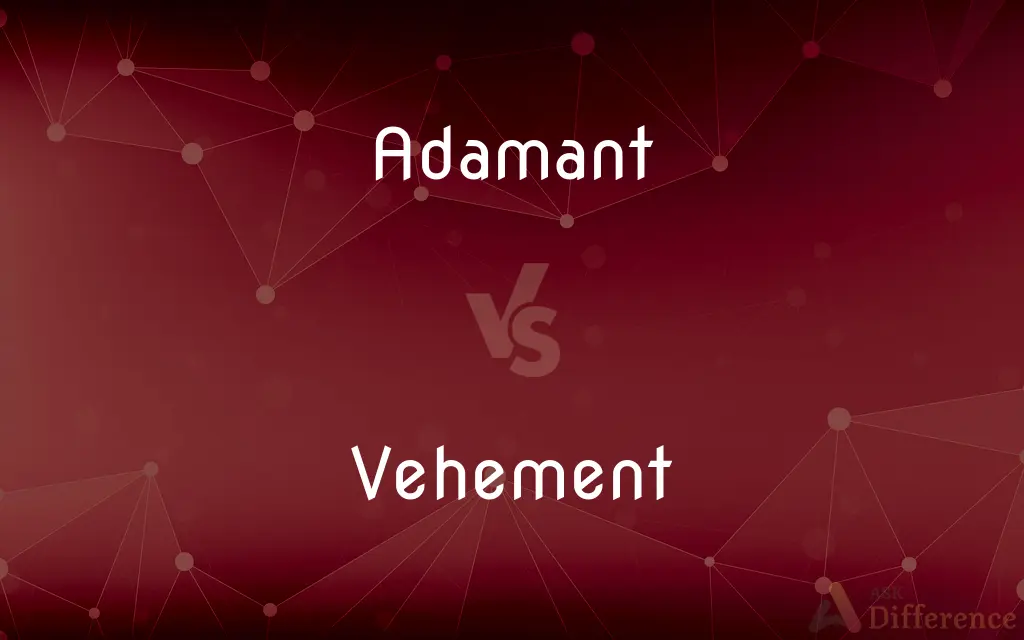Adamant vs. Vehement — What's the Difference?
By Urooj Arif & Maham Liaqat — Updated on March 14, 2024
Adamant refers to being unyielding or firm in attitude or opinion, while vehement implies intensity or forcefulness in expression or feeling.

Difference Between Adamant and Vehement
Table of Contents
ADVERTISEMENT
Key Differences
Being adamant is characterized by a steadfast refusal to change one's mind or position on a particular matter. This trait showcases a person's resolve and determination to maintain their stance, regardless of opposing arguments or pressures. In contrast, being vehement is marked by the passionate and forceful expression of feelings, opinions, or desires. A vehement response is not just about holding a strong belief but about expressing it with intensity and emotion, such as in a heated debate or in defending a deeply held conviction.
Adamancy often pertains to the internal, personal resolve of an individual, focusing on the steadfastness of their beliefs or decisions. It highlights an inner strength or firmness that resists external influences or persuasion. On the other hand, vehemence is more about the external expression of one's feelings or beliefs, characterized by the vigor, energy, or passion with which these are conveyed. This can be observed in the way someone argues a point or champions a cause, where the emphasis is on the strength and fervor of the delivery.
While an adamant person is primarily defined by their refusal to budge from a particular stance or viewpoint, suggesting a certain rigidity or inflexibility, a vehement individual is defined by the depth and power of their emotions or expressions. Vehemence can sometimes be persuasive or compelling due to its intensity, even if it doesn't always involve a refusal to change one's position.
In terms of communication, adamancy might manifest in a calm, unyielding insistence on a particular point, often accompanied by a refusal to engage further on the matter. This could be seen in a situation where someone firmly states their final decision without entertaining further discussion. Conversely, vehemence is typically more dynamic and expressive, possibly involving raised voices, emphatic gestures, or strong language, as seen in passionate speeches or debates.
The implications of being adamant versus being vehement can also differ in social or interpersonal contexts. Adamancy can be perceived as a sign of strong character or stubbornness, depending on the perspective, and can sometimes lead to standoffish or intractable situations. Vehemence, while it can convey conviction and sincerity, might also be seen as aggressiveness or emotional volatility, depending on the context and the manner in which it is expressed.
ADVERTISEMENT
Comparison Chart
Definition
Firm in attitude or opinion
Intense or forceful in expression
Focus
Internal resolve
External expression
Characteristic
Refusal to change position
Passionate delivery
Communication
Calm insistence
Dynamic and expressive
Social Implication
Perceived as strong or stubborn
Can be seen as sincere or aggressive
Compare with Definitions
Adamant
Unyielding in attitude or opinion.
Despite the criticism, she remained adamant about her decision.
Vehement
Forceful in expression or intensity.
She made a vehement plea for justice.
Adamant
Firmly fixed or decided, especially in refusing to change one's mind.
He was adamant that the project would continue as planned.
Vehement
Showing strong and passionate feelings.
His vehement opposition to the proposal took everyone by surprise.
Adamant
Characterized by inflexibility and determination.
The negotiator was adamant in refusing to make further concessions.
Vehement
Emphasizing conviction through intense emotion.
There was a vehement tone in her voice as she defended her beliefs.
Adamant
Resolute in maintaining a stance.
She was adamant about not compromising on quality.
Vehement
Marked by great energy or fervor.
The advocate was known for his vehement speeches.
Adamant
Showing an unwavering commitment to a position.
He remained adamant in his support for the cause.
Vehement
Characterized by passionate intensity.
The debate became more heated with his vehement arguments.
Adamant
Adamant in classical mythology is an archaic form of diamond. In fact, the English word diamond is ultimately derived from adamas, via Late Latin diamas and Old French diamant.
Vehement
Showing strong feeling; forceful, passionate, or intense
Her voice was low but vehement
Vehement criticism
Adamant
Refusing to be persuaded or to change one's mind
He is adamant that he is not going to resign
Vehement
Characterized by forcefulness of expression or intensity of emotion or conviction; fervid
A vehement denial.
Adamant
A legendary rock or mineral to which many properties were attributed, formerly associated with diamond or lodestone.
Vehement
Showing strong feelings; passionate; forceful or intense.
Adamant
Not willing to change one's opinion, purpose, or principles; unyielding.
Vehement
Acting with great force; furious; violent; impetuous; forcible; mighty; as, a vehement wind; a vehement torrent; a vehement fire or heat.
Adamant
A stone once believed to be impenetrable in its hardness.
Vehement
Very ardent; very eager or urgent; very fervent; passionate; as, a vehement affection or passion.
Adamant
An extremely hard substance.
Vehement
Marked by extreme intensity of emotions or convictions; inclined to react violently; fervid;
Fierce loyalty
In a tearing rage
Vehement dislike
Violent passions
Adamant
(said of people and their conviction) Firm; unshakeable; unyielding; determined.
Vehement
Characterized by great force or energy;
Vehement deluges of rain
Vehement clapping
A vehement defense
Adamant
(of an object) Very difficult to break, pierce, or cut.
Adamant
An imaginary rock or mineral of impenetrable hardness; a name given to the diamond and other substances of extreme hardness.
Adamant
An embodiment of impregnable hardness.
Adamant
(obsolete) A lodestone.
Adamant
A stone imagined by some to be of impenetrable hardness; a name given to the diamond and other substances of extreme hardness; but in modern mineralogy it has no technical signification. It is now a rhetorical or poetical name for the embodiment of impenetrable hardness.
Opposed the rocky orbOf tenfold adamant, his ample shield.
Adamant
Lodestone; magnet.
As true to thee as steel to adamant.
Adamant
Very hard native crystalline carbon valued as a gem
Adamant
Not capable of being swayed or diverted from a course; unsusceptible to persuasion;
He is adamant in his refusal to change his mind
Cynthia was inexorable; she would have none of him
An intransigent conservative opposed to every liberal tendancy
Common Curiosities
Is being adamant always negative?
Not necessarily; being adamant can be viewed positively as a sign of strong principles or negatively as stubbornness, depending on the context.
Does being adamant imply a lack of openness?
Being adamant often implies a firm stance that might be perceived as a lack of openness to change or new ideas, but it can also reflect a deep commitment to certain values.
What are the potential risks of being vehement in professional settings?
In professional contexts, excessive vehemence might be seen as unprofessional or aggressive, potentially harming one's credibility or interpersonal relations.
Is vehemence always associated with anger?
While vehemence often involves strong emotions, it doesn't always equate to anger; it can also express positive passions, such as enthusiasm or fervent support.
Can vehemence be effective in persuasion?
Vehemence, with its intensity and passion, can be persuasive to an audience if it's perceived as genuine and is well-directed.
Can someone be both adamant and vehement?
Yes, an individual can be both unyielding in their position (adamant) and express their views with strong emotion or passion (vehement).
How can adamancy affect relationships?
Adamancy can lead to conflicts or impasses in relationships if one party is perceived as unwilling to consider alternative viewpoints or compromises.
Can vehemence be controlled or moderated?
Individuals can learn to moderate their vehemence to ensure their passionate expressions are constructive and not overwhelming or counterproductive.
Can vehemence be a sign of sincerity?
Yes, vehemence can be interpreted as a sign of sincerity and conviction, as it shows a deep emotional investment in a cause or viewpoint.
How is adamancy perceived in leadership?
In leadership, adamancy can be seen as decisiveness or rigidity, depending on whether the firm stance is aligned with collective goals and values.
Share Your Discovery

Previous Comparison
Even vs. Level
Next Comparison
Affluence vs. ProsperityAuthor Spotlight
Written by
Urooj ArifUrooj is a skilled content writer at Ask Difference, known for her exceptional ability to simplify complex topics into engaging and informative content. With a passion for research and a flair for clear, concise writing, she consistently delivers articles that resonate with our diverse audience.
Co-written by
Maham Liaqat














































